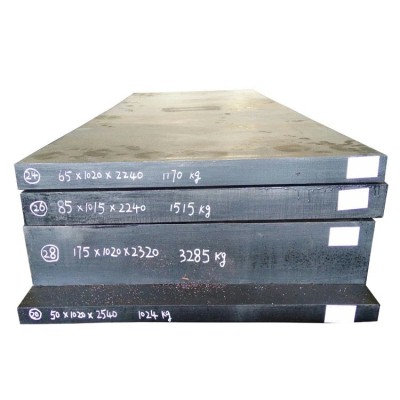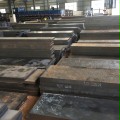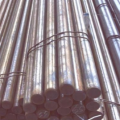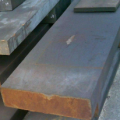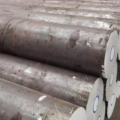Detailed Introduction
Model : M42/1.3247/HS2-9-1-8/S2-10-1-8/W2Mo9Cr4VCo8
Application : high speed steel
Content : Equivalent Steel with exact or nearest equivalents
|
Grade |
C |
Si |
Mn |
P |
S |
Cr |
V |
W |
Mo |
Co |
|
M42 |
1.05-1.15 |
0.15-0.65 |
0.15-0.40 |
≤0.03 |
≤0.03 |
3.50-4.25 |
0.95-1.35 |
1.15-1.85 |
9.00-10.00 |
7.75-8.75 |
|
Grade |
C |
Si |
P |
S |
Cr |
Mo |
V |
W |
Co |
|
|
1.3247 |
1.05-1.15 |
≤0.70 |
≤0.03 |
≤0.03 |
3.50-4.50 |
9.00-10.00 |
0.90-1.30 |
1.20-1.90 |
7.50-8.50 |
|
|
Grade |
C |
Si |
P |
S |
Cr |
Mo |
V |
W |
Co |
|
|
HS2-9-1-8 |
1.05-1.15 |
≤0.70 |
≤0.03 |
≤0.03 |
3.50-4.50 |
9.00-10.00 |
0.90-1.30 |
1.20-1.90 |
7.50-8.50 |
|
|
Grade |
C |
Mn |
Si |
P |
S |
Cr |
V |
W |
Mo |
Co |
|
W2Mo9Cr4VCo8 |
1.05-1.15 |
0.15-0.40 |
05-0.65 |
≤0.03 |
≤0.03 |
3.5-4.25 |
0.95-1.35 |
1.15-1.85 |
9.00-10.00 |
7.75-8.75 |
M42 steel is a high-cobalt toughness high-speed steel, mainly used for high toughness, precision wear-resistant hardware cold punching dies.
M42 steel can also can cut tools and knives in cooling condition . M42 steel has high hardness, up to 70HRC, good thermal hardness, high temperature hardness, and easy to grind.
Cutting tools made of this steel can cut iron-based superalloys, cast superalloys, titanium alloys and ultra-high-strength steels, etc., but the toughness is slightly worse, and the lower limit of the temperature during quenching should be adopted. Because of its good grinding performance, it can be used to manufacture various high-precision and complex tools.
M42 with mostly special for its High red heat hardness, high wear resistance and cutting ability, high impact toughness. Fine and uniform grains, high toughness.
Heat treatment
Warm fire: temperature 800~880℃, 10~20℃, dHr furnace cooled to about 600℃, the hardness is above HB269.
Stress relief: temperature 650~750℃, cooling in furnace
Application in life
- Tool industry: scrapers, hobbing knives, iron knives, drills, etc.
- Forging industry: forging die
- Screw industry: Hexagonal head forming molds, tooth taps, punches
M42 high speed steel
High-speed steel generally does not do tensile strength testing, but mainly metallographic and hardness testing. After the correct heat treatment of tungsten and molybdenum high-speed steels, the Rockwell hardness can reach more than 63, and the cobalt-based high-speed steel can be more than 65.
The acid-leached low-magnification structure of steel shall not have visible shrinkage holes and peeling. The center is loose, generally the looseness should be less than level .
The content of metallographic inspection mainly includes 3 items of decarburized layer, microstructure and carbide unevenness. High-speed steel should not have obvious decarburization. The microstructure must not have herringbone eutectic ledeburite.
The unevenness of carbides in high-speed steel has the greatest impact on quality. At present, the metallurgical and mechanical departments attach great importance to the level of unevenness of carbides. According to the different uses of the steel, different grade requirements can be put forward for the unevenness of carbides, which should be less than grade 3 under normal circumstances.
In addition to the high hardness, high wear resistance and sufficient toughness of cutting tools made of high-speed steel, there is another important factor that is red hardness.
Red hardness refers to the ability of the cutting edge to resist softening under red heat when the tool is cutting at high speed. One way to measure the red hardness is to first heat the steel to 580-650°C, keep it warm for 1 hour, and then cool it down, and then measure its hardness after repeated 4 times.
The quenching temperature of high-speed steel is generally close to the melting point of steel, such as 1210~1240℃ for tungsten high-speed steel and 1180~1210℃ for high-molybdenum high-speed steel. After quenching, it generally needs to be tempered 3 times between 540~560℃. Increasing the quenching temperature can increase the red hardness of the steel. In order to improve the service life of high-speed steel tools, the surface can be strengthened, such as low-temperature cyanidation, nitriding, and sulfur and nitrogen co-infiltration.
Solar Special Steel International Limited
Contact Person :Wendy
Telephone:+86 18688633122 whatsapp&wechat
Skype: .cid.8920082fecfa0b5c
Email:ss@solarsteel.cn


